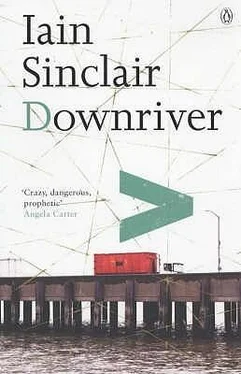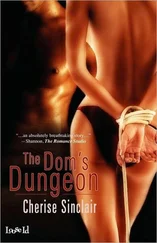The Goat also plays with our prejudices. Tenniel, in giving him no hands, signals his innocence. He claims to have dozed through the whole thing. He is cancelled by rapid horizontal strokes of the pen; cast into the river with the other fall-guys. His name goes into the files of the Black Museum, along with his spectacles, his cufflinks, and his wing-collar. After a decent interval, he will be ‘fingered’ by Colin Wilson — as a blood-guzzling ritualist. His horns will be mounted on the wall of Donald Rubelow’s office. His ‘suicide’ will close the case. The pebbles from his pocket will be returned to the proper authorities.
We are left, once again, with the classic Agatha Christie railway solution: they orl dunit . Railways beget conspiracies: Ethel Lina White’s The Wheel Spins (filmed by Hitchcock as The Lady Vanishes ), with nuns in high heels, injections, bandages; or Patricia Highsmith’s smoking-car collaborators, exchanging crimes (also translated by Hitchcock, with the ‘help’ of Raymond Chandler); or so many more of the ‘Master’s’ nightmares from the first Thirty-nine Steps to North by Northwest . This man, a true son of Wanstead, must be pulled in for questioning. Tenniel’s dark frame is a trailer for Rear Window . And we have established by now that being dead is no excuse at all.
In making his drawing look so much like a film noir production still is Tenniel telling us something? He makes us consider the role of Lewis Carroll as a compulsive photographer of nymphets. He reminds us that Carroll’s text is an elaborate chess game: ‘ the final “checkmate” of the Red King will be found, by any one who will take the trouble to set the pieces and play the moves as directed, to be strictly in accordance with the laws of the game ’. There are no counterfeit tricks: follow Carroll’s moves closely enough and he reveals his own guilt, as we all do. He plays the self-inquisitor, employs whimsy, teasing so savagely that he bruises his flesh. He has the arrogance to scatter incriminating messages he is sure we will be too stupid to interpret.
Have other ‘psychic detectives’ penetrated this mystery years before us? The only crimes worth solving are the ones that have not yet been committed: they are still formally immaculate. William Hope Hodgson narrates his ‘Carnacki the Ghost-finder’ tales through the medium of his own ‘Late Watson’; a narrative ‘I’ who is unmasked as ‘Dodgson’ (Charles Lutwidge, perhaps? Author of Phantasmagoria and Other Poems : the ‘real’ Lewis Carroll) in The Gateway of the Monster . The supernumerary trio of disciples who attend Carnacki’s ‘evenings’ are frequently named: Arkright, Jessop, Taylor (Science, Cricket, Neo-Platonism?) — but ‘Dodgson’ is, I believe, mentioned in only two tales; ‘The Gateway of the Monster’ and ‘The Hog’ (which did not feature as part of the original Carnacki canon, and was not included in the wrappered summary of 1910, nor the Eveleigh Nash collection of 1913). ‘Dodgson’ reports the adventures (fantastic-domestic survivals from the Looking-glass World), but — unlike Dr Watson — he is never a participant. Both these men are, of course, the true authors: they are able safely to share the terrors no outside agency has invoked. ‘ Some evening I want to tell you about the tremendous mystery of the Psychic Doorways. In the meantime, have I made things a bit clearer to you, Dodgson ?’
Tenniel, like Walter Sickert with the Ripper murders, mistook his own obsessions for guilt. He invented elaborate fables to account for his involvement in the knowledge of these terrible sacrifices. Sir John, it should be remembered, joined the staff of Punch in 1851, and produced, after the death of Leech, its principal weekly political cartoon. Now look again at the artist’s heraldic sigil in the bottom left-hand corner of ‘Alice in the Train’. It is exactly the same as the initials you will find imposed in the same position in that most famous of all ‘Ripper’ icons: ‘The Nemesis of Neglect’ (the hooded, knife-wielding spectre with CRIME printed on its forehead). Sir John Tenniel was responsible for both images. (A ‘lost’ word — part-rune, part-mirror script — is buried on the floor beneath Alice’s feet: like the whispers on the dead track at the finish of the Sergeant Pepper LP.)
The collaboration with Carroll, and the production of this clairvoyant illustration gave Tenniel the chance to accuse the killer, whose identity he knew — because he had, at some level , shared in the crime. His capped (or crowned) Guard wears the Diamond and stares, eyeless, at the girl: because he is, or stands for, the Red King . He is checkmated. The Goat accuses him, a Tarot Devil, representing ‘ravishment, force, fatality’. So Tenniel is able to put into his depiction of Alice the details of the murders that the police have never made public. The hands of the victims were always tied in front of them — as Alice’s are, within her muff. They were all strangled with a knotted scarf, such as the one that Alice wears. And a single feather was knotted into their hair . I rest my case.
But wait a minute: didn’t Joblard procure a quantity of these same gulls’ feathers for his installation in the London Fields gallery? I must check the files. Yes, it’s there in the Flash Art review: ‘From the dereliction of the East End one passes into the labyrinthine interior and then via a metal staircase (under each step of which a feather has been placed — the Angel’s wing of ascension) to the threshold…’ The feather or quill is an obvious invocation of the idea of ‘inscription’, with its darker twin — confession. Joblard is the guilty man: the Bird-Revenger.
No, no, no. It’s worse than that: if the details of the murders have never been made public — how do I know what they are ? I put up my hand, confess. The relief! In the end every writer confesses. It proves nothing; a kind of boast. I must draw on the anger of women to escape from this quilted cage, a strength we will never understand, and transcribe as ‘will’, ‘stubbornness’, or some other biological imperative.
I allow the conceit of my house to form around me: the armour plating of an insect-samurai. I can stick the Tenniel postcard, with a stub of sugar-free gum, on to the window of the phoney carriage — and walk out, be somewhere else. That is the power of the narrator. I need to consult The Crystal Cabinet of Mary Butts, and I climb the rackety ladder into the attic, to search for it. (‘ The equivocal nature of the contact between visible and invisible, the natural order and the supernatural .’)
I sit in a hutch of darkness, holding a torch, illicitly leafing through John Symonds’s account of Mary Butts visiting Crowley at Cêfalu, the Abbey of Thelema. The Great Beast offered Butts ‘cakes of light’ — the Host, in the form of ‘a goat’s turd on a plate’. Which she, unceremoniously, declined.
I am walled in by cases of books (unsold stock, forgotten purchases) that will only be read by torchlight. Extracts. Quotations. Specimen sentences questing for meaning. Any one of them could alter the balance of the tale, and postpone that hideous moment of silence — when your turn at the fireside is concluded; the audience demand that you sit down. ( Just a moment more .)
This awkward space has none of the spontaneous chaos of Rodinsky’s room. It contains all the material that no longer fits into our lives: clothes we do not wear, letters we shall never again read, cricket bats with lumps knocked out of them. I was finally able to suspend my unfocused quest when I came upon a drawing book in which my daughter, aged about three and a half, had executed a sequence of curious sketches, featuring bubble-headed, tendril-writhing figures. Her mother then took down the child’s terse ‘explanations’ on the opposite leaf. The point was that the illustrations preceded the stories, and explained the unexplainable — only because her mother expected it. The child was perfectly capable of obliging some formal requirement, and ‘doing her own thing’ at the same time.
Читать дальше












